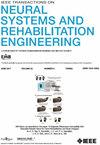Enhancing Neural Activation in Older Adults: Action Observation-Primed Swallowing Imagery Reveals Age-Related Connectivity Patterns
IF 4.8
2区 医学
Q2 ENGINEERING, BIOMEDICAL
IEEE Transactions on Neural Systems and Rehabilitation Engineering
Pub Date : 2025-04-21
DOI:10.1109/TNSRE.2025.3562573
引用次数: 0
Abstract
Aging-related swallowing decline, known as presbyphagia, significantly increases the risk of dysphagia and aspiration pneumonia in older adults. Enhancing cortical activation and functional connectivity through non-invasive methods is crucial for improving swallowing function. This study investigates the use of action observation (AO) as a priming method to enhance motor imagery (MI) for promoting swallowing-related cortical activity. A total of 22 healthy young adults and 20 healthy older adults were recruited. Participants completed two swallowing imagery tasks: an 8-minute AO-primed task and an 8-minute unprimed task. Functional near-infrared spectroscopy was used to measure changes in oxyhemoglobin concentration as an indicator of cortical activation. Corrected imaginary phase-locking values (ciPLVs) were calculated to estimate functional connectivity between brain regions. In young adults, AO-primed tasks showed widespread bilateral activation in the sensorimotor cortex, supplementary motor area (SMA), and visual cortex, while unprimed tasks activated only the right inferior frontal gyrus. In older adults, AO-primed tasks activated the left sensorimotor cortex, SMA, and visual cortex, but unprimed tasks did not result in any significant cortical activation. Despite both age groups recruiting similar cortical networks, older adults exhibited reduced connectivity, particularly in the prefrontal-sensorimotor pathways during AO-primed tasks. AO-priming enhances cortical activation and connectivity in both young and older adults during swallowing imagery tasks. However, older adults demonstrate weaker neural connectivity, suggesting that age-related cortical decline may limit the effectiveness of such interventions. AO-primed MI may serve as a promising strategy for improving swallowing function in older populations.增强老年人的神经激活:动作观察启动吞咽图像揭示与年龄相关的连接模式
与年龄相关的吞咽功能减退,即吞咽前症,会显著增加老年人发生吞咽困难和吸入性肺炎的风险。通过非侵入性方法增强皮质激活和功能连接对于改善吞咽功能至关重要。本研究探讨了使用动作观察作为启动方法来增强运动意象(MI),以促进吞咽相关的皮层活动。总共招募了22名健康的年轻人和20名健康的老年人。参与者完成了两个吞咽图像任务:一个8分钟的ao启动任务和一个8分钟的无启动任务。功能近红外光谱测量血红蛋白浓度的变化,作为皮质激活的指标。计算修正的虚锁相值(ciplv)来估计脑区域之间的功能连接。在年轻人中,ao启动的任务在感觉运动皮层、辅助运动区(SMA)和视觉皮层中表现出广泛的双侧激活,而未启动的任务仅激活右侧额下回。在老年人中,ao启动的任务激活了左侧感觉运动皮层、SMA和视觉皮层,但未启动的任务没有导致任何显著的皮层激活。尽管两个年龄组的大脑皮层网络相似,但老年人表现出较低的连通性,特别是在ao启动任务中前额叶-感觉运动通路。在吞咽意象任务中,ao启动增强了年轻人和老年人皮层的激活和连通性。然而,老年人表现出较弱的神经连通性,这表明与年龄相关的皮层衰退可能会限制此类干预措施的有效性。ao引发的心肌梗死可能是改善老年人吞咽功能的有希望的策略。
本文章由计算机程序翻译,如有差异,请以英文原文为准。
求助全文
约1分钟内获得全文
求助全文
来源期刊
CiteScore
8.60
自引率
8.20%
发文量
479
审稿时长
6-12 weeks
期刊介绍:
Rehabilitative and neural aspects of biomedical engineering, including functional electrical stimulation, acoustic dynamics, human performance measurement and analysis, nerve stimulation, electromyography, motor control and stimulation; and hardware and software applications for rehabilitation engineering and assistive devices.

 求助内容:
求助内容: 应助结果提醒方式:
应助结果提醒方式:


